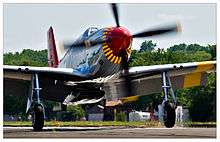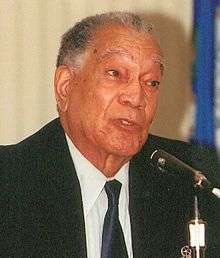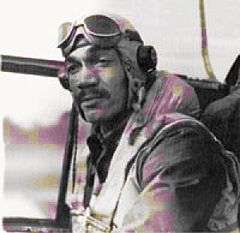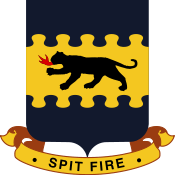Lee Archer (pilot)
| Lee Andrew Archer, Jr. | |
|---|---|
|
Lee Archer during World War II | |
| Nickname(s) | Buddy |
| Born |
September 6, 1919[1] Yonkers, New York, United States |
| Died |
January 27, 2010 (aged 90)[2] Manhattan, New York City, New York, United States |
| Allegiance |
|
| Service/branch |
United States Army Air Corps United States Army Air Forces United States Air Force |
| Years of service | 1941–1970 |
| Rank |
|
| Unit |
302nd Fighter Squadron Tuskegee Airmen |
| Battles/wars |
World War II Korean War |
| Awards |
Air Force Distinguished Service Medal Distinguished Flying Cross Air Medal (18 clusters) Distinguished Unit Citation Congressional Gold Medal |
Lee Andrew Archer, Jr. (September 6, 1919 – January 27, 2010) was a black U.S. fighter pilot in the African-American unit which became known as the Tuskegee Airmen. He was one of the first African-American military aviators in the United States Army Air Corps, the U.S. Army Air Forces and later the U.S. Air Force, eventually earning the rank of Lieutenant Colonel.
During World War II, Archer flew 169 combat missions, including bomber escort, reconnaissance and ground attack, and is officially credited with 4.5 enemy fighter aircraft shot down.[3]
Early life
Born in Yonkers, New York, Archer grew up in New York's Harlem district, later attending New York University. Upon graduation, he joined the Army in the hopes of becoming a pilot. At that time, the Army did not accept black pilots, so Archer was posted to a communications job as a telegrapher and field network-communications specialist in Georgia.[4] When the Army's policy changed, he was accepted to the training program for black aviators at Tuskegee Army Airfield in Alabama, graduating first in his class,[5][6] and one of only 994 black wartime pilots to graduate there. He was commissioned as a Second Lieutenant on July 28, 1943.[7]
World War II

Archer is considered by some as the first and—as of 2010—only black U.S. pilot to earn an "ace" designation, for shooting down at least five enemy aircraft.[9][10] Archer was acknowledged to have shot down four planes, and he and another pilot both claimed victory for shooting down a fifth aircraft. An investigation revealed Archer had inflicted the damage that destroyed the aircraft, and the Air Force eventually proclaimed him an ace pilot.[10] He also destroyed six aircraft on the ground during a strafing mission in August 1944, as well as several locomotives, motor transports and barges.[6][10]
While flying with the 302nd Fighter Squadron, as a combat pilot, nicknamed "Buddy", Archer flew 169 combat missions in the European Theatre of World War II, flying the Bell P-39 Airacobra, Republic P-47 Thunderbolt and North American P-51 Mustang fighter aircraft.[N 2][11] Flying a P-51C fighter with the distinctive red tail of the 332nd Fighter Group, known collectively as the "Tuskegee Airmen", he scored his first victory, a Messerschmitt Bf 109 on July 18, 1944 over Memmingen, Germany.[N 3][7]
Archer is best remembered for his exploits of October 12, 1944.[13] In the midst of a furious series of dogfights over German-occupied Hungary, he shot down three Hungarian Bf 109s over Lake Balaton, Hungary, in engagements that spanned only 10 minutes.[7]
The claim that Lee Archer scored, in addition to his awarded victory on July 18, 1944, an additional victory or half a victory that day has been disputed by US Air Force historian Daniel L. Haulman. According to the group history and Fifteenth Air Force mission reports, Archer claimed and was awarded a credit on July 18, 1944, and did not share an additional victory with anyone else. The pilot with whom Archer is sometimes said to have shared the credit, Freddie Hutchins, did not earn an aerial victory credit or a half aerial victory on that particular day. No other pilot in Archer's squadron or group earned a half credit that day. Archer's next three victories occurred on a single mission in October 1944.[12]
Frank Olynyk, an historian for the American Fighter Aces Association,[14] also acknowledged that while the organization named Archer as an honorary ace, he was not named an official ace due to the fact he was unable to produce any record confirming he shot down five planes.[15] According to Olynyk, Archer never alleged that he shot down five planes and that the claim originated after his last name was mistaken with that of another Tuskegee pilot with the last name "Arthur."[15] However, Olynyk also acknowledged that Archer did believe he shared an additional victory with another pilot and the official combat record which could have confirmed this was stolen from his car shortly after he returned home when the war ended.[15]
When Archer returned home in 1945, a recipient of the Distinguished Flying Cross, he found that nothing seemed to have changed in American society. "I flew 169 combat missions when most pilots were flying 50," Archer told the Chicago Tribune in 2004. "When I came back to the U.S. and down that gangplank, there was a sign at the bottom: ′Colored Troops to the Right, White Troops to the Left′."[5]
Archer remained in the armed forces for a career as the U.S. Army Air Forces transitioned into the present day U.S. Air Force in 1947. He later flew missions during the Korean War,[7] became a diplomatic officer at Supreme Headquarters Allied Powers Europe (SHAPE) and then became the headquarters chief of the U.S. Air Force Southern Command in Panama,[16] eventually retiring as a lieutenant colonel in 1970.[10]
Later career

.jpg)
After retiring from the military, Archer joined General Foods Corporation in White Plains, N.Y. where he became one of the first black corporate vice presidents of a major U.S. company. While there he also led its small-business investment subsidiary, North Street Capital Corporation, which serviced clients such as Essence Communications and Black Enterprise Magazine. In 1987 he helped establish the food conglomerate TLC Beatrice and in the same year founded the venture capital firm Archer Asset Management.[17] Archer became a longtime resident of New Rochelle, New York.
In October 2005, Archer and two fellow Tuskegee veterans, retired Technical Sergeant George Watson Sr. and Master Sergeant James A. Shepherd, visited Balad Air Base at Balad, Iraq, to meet with 700 servicemen from the 332nd Air Expeditionary Wing, the successor unit to his all-black outfit.
"This is the new Air Force," he told The Associated Press. In the dining room, he said, he saw "black, white, Asian, Pacific Islanders, people from different parts of Europe. This," he said, "is what America is."[18]
Illness and death
In April 2009, Archer was selected to be an adviser for the George Lucas produced film, Red Tails.[19] Archer, aged 90, died at Cornell University Medical Center in New York City on January 27, 2010, as a result of coronary complications, according to his son Roy Archer.[4][10] His death came during the post-production work on the Lucas film Red Tails, and the film's final credits subsequently bore a tribute to the pilot.[19] At a memorial service for Archer held at the Riverside Church on February 4, entertainer and commentator Bill Cosby gave a eulogy.[20]
Archer was predeceased by his wife, Ina Burdell, who died in 1996 and was survived by his three sons, one daughter and four granddaughters.[5][17] He is buried at Arlington National Cemetery.[20]
Awards and tributes
Military awards
- Command Pilot Wings
- Distinguished Flying Cross
- Meritorious Service Medal
- Air Medal with three silver and two bronze oak leaf clusters
- Air Force Commendation Medal with oak leaf cluster
- Distinguished Unit Citation
- Good Conduct Medal
- American Campaign Medal
- European-African-Middle Eastern Campaign Medal with three campaign stars
- World War II Victory Medal
- National Defense Service Medal with service star
- Korean Service Medal
- Air Force Longevity Service Ribbon with silver oak leaf cluster (6 awards)
- Air Force Marksmanship Ribbon
- Legion of Honor (France)
- United Nations Korea Medal
Source - [21]
Other honors
- Archer earned special citations for his work from Presidents Dwight D. Eisenhower, John F. Kennedy and Lyndon B. Johnson.[16]
- Archer and his fellow Tuskegee airmen were awarded the Congressional Gold Medal in 2007.[22]
- Archer was an Honoree of the American Fighter Aces Association.[23]
- Aviation warplane collector and pilot Kermit Weeks restored and flew a P-51 fighter painted in tribute to Archer, in the colorful markings of Archer's "Ina the Macon Belle", originally dedicated to his wife, Ina Burdell.[7]
- A youth flight training program was established in honor of Lee A. Archer Jr. by Glendon Fraser, President of the Major General Irene Trowell-Harris chapter of the Tuskegee Airmen, Inc. The Lee A. Archer Jr., Red Tail Youth Flying Program operates out of Newburgh, New York and accepts high school students from the Orange County, New York area.
- Freedom medal[24]
See also
References
Notes
- ↑ Markings that distinguished the Tuskegee Airmen included red bands on the noses of P-51s as well as a red rudder; their P-51B, C and D Mustangs flew with similar color schemes, with red propeller spinners, yellow wing bands and all-red tail surfaces.[8]
- ↑ During the latter part of the war, Archer flew a North American P-51C Mustang, sporting "Ina The Macon Belle" on its nose, named after his wife, Ina, and adorned with a Zoot-suited "Hep Cat" painted on its rear fuselage.[7]
- ↑ On this mission the 332d FG was escorting B-17s of the 483d Bomb Group. Although 15 Fortresses were lost to fighter interception in the fierce air battle, the 332d was credited with nine victories including Archer's.[12]
Citations
- ↑ "National Visionary Leadership Project: Lee Archer." visionaryproject.com. Retrieved: December 26, 2012.
- ↑ "Former Tuskegee Airman, 90, dies in NYC." Atlanta Journal Constitution, January 28, 2010.
- ↑ https://web.archive.org/web/20100410024006/http://www.af.mil/information/heritage/spotlight.asp?id=123190643
- 1 2 Lt. Col. "Lee Archer, Tuskegee Airman, Passes." U.S.A.F. (official website), January 29, 2010.
- 1 2 3 Goldstein, Richard. "Lee A. Archer Jr., Tuskegee Fighter Pilot, Dies at 90." The New York Times, February 3, 2010. Retrieved: February 5, 2012.
- 1 2 "Lieutenant-Colonel Lee Archer." The Telegraph, January 29, 2010.
- 1 2 3 4 5 6 White, Troy. "Tuskegee Airman Lt. Lee 'Buddy' Archer." StardustStudios.com, 2011. Retrieved: December 26, 2012.
- ↑ Rice, Markus. "The Men and Their Airplanes: The Fighters." Tuskegee Airmen, 1 March 2000.
- ↑ Francis 1955, pp. 92, 194.
- 1 2 3 4 5 "Tuskegee Airmen Ace of World War II, Dies." CBS News, January 29, 2010. Retrieved: December 25, 2012.
- ↑ Tillman 2012, p. 24.
- 1 2 Haulman, Dr. Daniel L. "Misconceptions About the Tuskegee Airmen." AFHRA. Retrieved: 26 October 2013.
- ↑ Francis and Cato 1997, p. 146.
- ↑ American Fighter Aces Association-contact Accessed August 21, 2014
- 1 2 3 Lee Archer, 4, 4.5 or 5 kills Accessed August 21, 2014
- 1 2 "Tuskegee Airman buried at Arlington." CNN, February 13, 2010.
- 1 2 "Lee A. Archer, Ace Tuskegee Airman and V.C., Dies." The New York Times website, January 29, 2010. Retrieved: December 25, 2012.
- ↑ "Aging Tuskegeee Airmen visit Air Force unit in Iraq." Gadsden Times, October 29, 2005. Retrieved: February 5, 2012.
- 1 2 "Lee A. Archer Jr." Legacy.com, February 3, 2010. Retrieved: February 24, 2012.
- 1 2 "Dr. William H. "Bill" Cosby Jr., American actor and comedian, delivers a eulogy during a memorial service for retired U.S. Air Force Lt. Col. Lee A. Archer." United States Department of Defense, February 7, 2010. Retrieved: February 5, 2012.
- ↑ http://www.veterantributes.org/TributeDetail.php?recordID=681
- ↑ Byrne, Virginia. "Lee Archer - Tuskegee Airman - dies." San Francisco Chronicle, January 31, 2010. Retrieved: February 5, 2012.
- ↑ "Gala Luncheon Saturday, June 13, 2009; Reginald F. Lewis Foundation." www.reginaldflewis.com, June 5, 2009. Retrieved: February 5, 2012.
- ↑ Four Freedoms Award#Freedom Medal
Bibliography
- Cooper, Charlie, Ann Cooper and Roy La Grone. Tuskegee's Heroes. St. Paul: Minnesota: Motorbooks International Publishing Company, 1996. ISBN 0-7603-0282-0.
- Francis, Charles E. The Tuskegee Airmen. Boston: Bruce Humpries, Inc., 1955.
- Francis, Charles E. and Adolph Caso. The Tuskegee Airmen: The Men Who Changed a Nation. Boston: Branden Books, 1997. ISBN 0-8283-2029-2.
- Haulman, Daniel L., Eleven Myths About the Tuskegee Airmen. Montgomery, Alabama: New South Books, 2011.
- Tillman, Barrett. "Tales of the Red Tails; Inside the Tuskegee Legend: The men, the machines, the missions." Flight Journal, February 2012.
External links
| Wikimedia Commons has media related to Lee Archer. |
- Lee Archer's oral history video excerpts at The National Visionary Leadership Project
- Lee Archer on the Internet Movie Database
- Lieutenant-Colonel Lee Archer - Daily Telegraph obituary

